
Posted by
Mordy Oberstein

To what extent do URLs share a Featured Snippet? What happens when Google uses more than one URL inside a Featured Snippet? Is there one URL that dominates the zero position box? What happens when Google oscillates between more than two URLs – how much visibility does each URL get?
Based on the results of our last Featured Snippet study, which analyzed how often Google changes a URL inside of Featured Snippets, we wanted to know what the market share of a Featured Snippet URL looks like.
Here’s what we found:
Putting the Featured Snippet Pieces Together
It’s worthwhile to recap how we got here. As mentioned, shortly before undertaking this study, I dug into how many times Google swaps the URLs used within a Featured Snippet over both a 30 and 90-day period. What I found was that overall, Google oscillates between two URLs within a given Featured Snippet (a bit under 2 over a 30-day period and a bit over 2 URLs during a 90-day period). The data also showed that over a 30-day period Google made just over two changes to the URL within the average Featured Snippet.
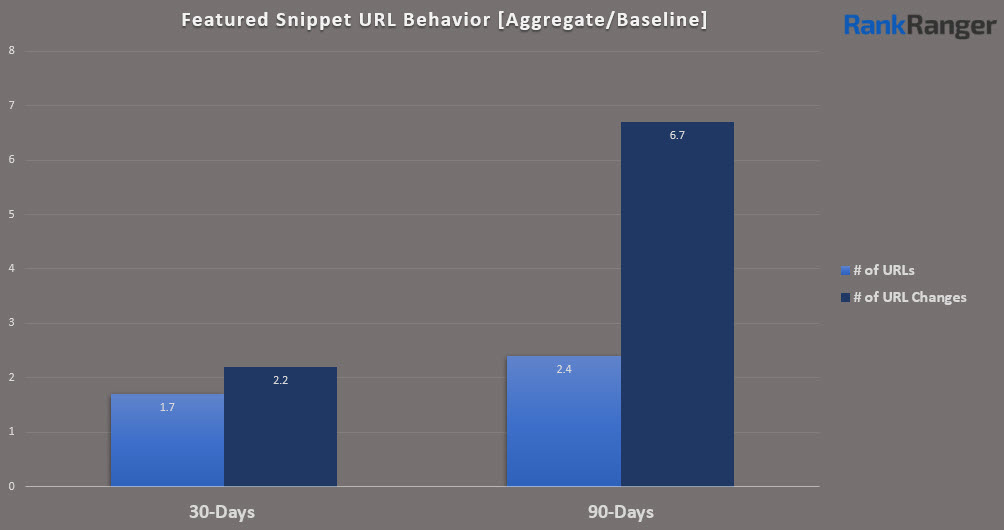
Despite studying numerous query types the study left me wanting a bit more. It’s one thing to know how many unique URLs Google places within a Featured Snippet over the course of the month but it’s another thing entirely to know each URL’s market share. Being that Google makes but two URL changes each month, and given that the search engine is predisposed towards using but two URLs within a Featured Snippet each month I wanted to know if one URL was more dominant than the other and if so to what extent.
To that end, and with the help of our eager team, we analyzed 300 keywords that produced a Featured Snippet (US – desktop) which utilized but two URLs over a 30-day period. From there we simply determined which URL was the most dominant (i.e., which URL appeared within the Featured Snippet the majority of the time) and calculated its market share.
What follows are the results of our efforts:
Featured Snippet URL Market Share
As mentioned, we took 300 Featured Snippet producing keywords that had but one criteria; Google only used two URLs within the zero position box over a 30-day period. The obvious goal was to see how Google’s tendency to show but two URLs within the Featured Snippet over the course of a month actually plays itself out.
This is what we found:
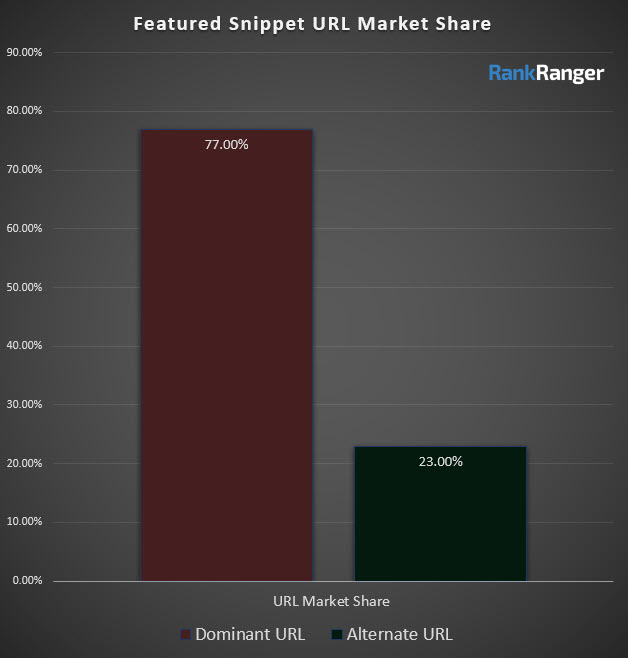
You’ll notice I refer to one URL as the dominant URL and the other as the alternate URL. That’s because for those instances where Google shows but two URLs within the Featured Snippet per month (and remember, that is the general trend) one URL is clearly the dominant URL. It’s not even close (on average, of course). One URL clearly takes up the vast majority of Featured Snippet market share, specifically over 77% of it. The second, or “alternate” URL (as will be referred to in this post), is present but 23% of the time during the average month.
Of course, nothing is as simple as it first appears as this data reflects the mean average.
The data returned when looked at from “percentage range” perspective tells a slightly different story. The chart below shows the number of “alternate” URLs that fell within the listed percentage ranges:
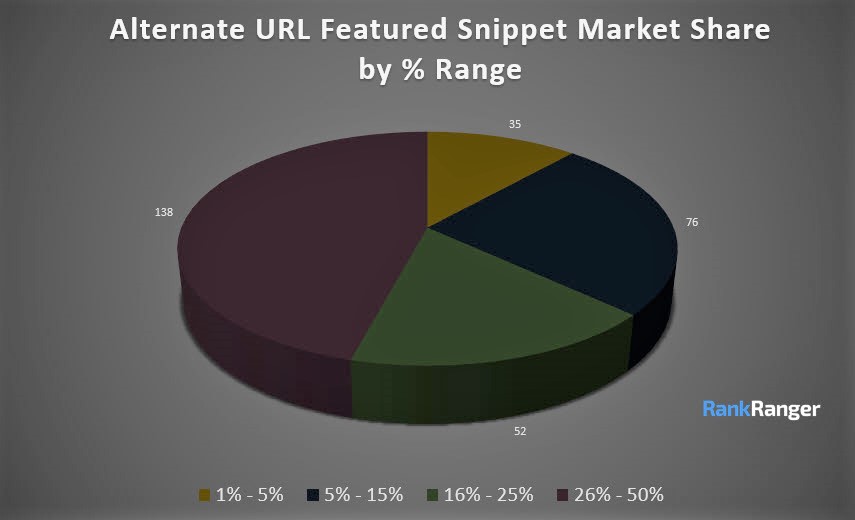
Looking at this data, there were a disproportionate number of alternate URLs that appeared within a Featured Snippet for a given keyword more than a quarter of the time. This means that nearly half of all the alternate Featured Snippet URLs studied (specifically 138 out of 300) had a market share above 25%. Even within the 26% – 50% range, 49 of the 138 URLs had a market share above 40% (that’s 36% of the URLs found within the range).
Conversely, only 35 URLs, or 11.5% of the total dataset, had a Featured Snippet market share of 5% or under. The point is, there are only a relatively few Featured Snippet URLs that represent a one-shot deal within the zero position box. That is, very few URLs are employed just once or twice during a 30-day period, relatively speaking. Compare that to the nearly 20% of URLs within the dataset that
Indeed, we recorded 11 instances where there was essentially no dominant URL, where there was a 50/50 split between the two URLs, which reflects about 3.5% of the keyword dataset analyzed. [Disclaimer: for these 11 instances, one URL was”deemed” the dominant URL and the other the alternate URL, however, in reality, you could look at either URL as being both the dominant or alternate link used. It all depends if you see the cup being half empty or half full.]
‘How-To’ Keywords and Alternate URL Market Share within the Featured Snippet
As we did when analyzing the average number of URLs used and URL swaps made within Featured Snippets, here too we pulled out the how-to keywords and analyzed them in isolation. This was done due to the highly relevant nature these queries represent vis-a-vis Featured Snippets. That is, the “how-to” query aligns to the most essential nature of what the Featured Snippet intends to achieve. Thus, it would be prudent to see if Google displays unique URL market share patterns for the keyword category.
An analysis of 52 Featured Snippet producing how-to keywords shows a nominal difference in the alternate URL’s market share when compared to the overall data-set:
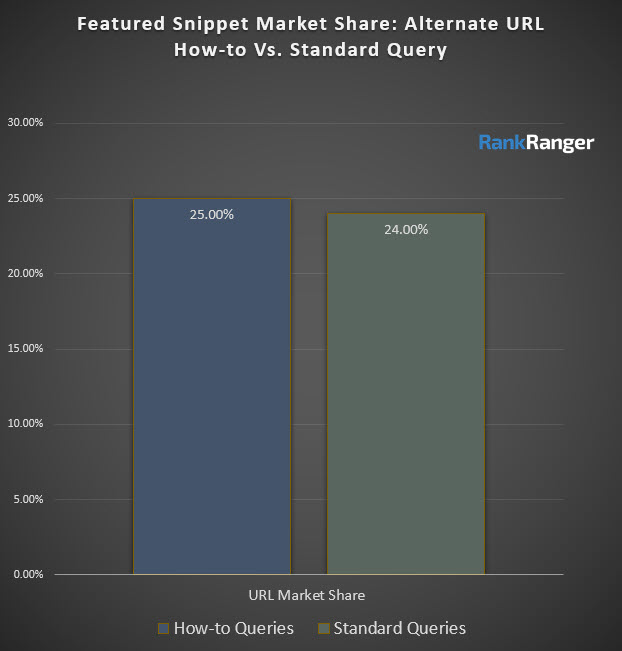
As is indicated, there is but a one percentage point difference between URLs representing how-to queries and those that reflect “generic” search terms.
At the same time, when I analyzed the dataset overall, I could find no commonality between the keywords that produced an alternate Featured Snippet URL with a substantial market share and those that produced URLs with a paltry market share. This would seemingly indicate that the dominance of the “preferred” URL has less to do with keyword type or user intent per se, but with Google’s overall strategy and approach to placing URLs within its ever-coveted zero position box.
Check out our guide to winning SERP features.
Featured Snippet URL Market Share for Multiple Alternates
As discussed earlier, the initial study undertaken showed that Google is predisposed towards alternating between two URLs for Featured Snippet placement. This is why the above data dealt only with keywords that produced Featured Snippets where just two URLs were utilized within a 30-day period.
That said, Google does go with multiple alternate URLs for its Featured Snippets. We wanted to get a taste of how market share looks in these instances. The issue is, the more URLs you add the more market “sharing” there has to be, by definition. Meaning, it’s not like you can analyze the Featured Snippet market share of all Featured Snippets with multiple alternate URLs. Rather, you would have to look at keywords with two URL alternates separately than those with three URL alternates and so forth.
Due to this, we surveyed keywords where Google made use of two alternate Featured Snippet URLs within a 30-day period. That is, we looked at keywords where Google employed three total URLs within the Featured Snippet over 30-days (the three URLs being the dominant URL and two alternate URLs). In such instances, the Featured Snippet URL market share looks as such:
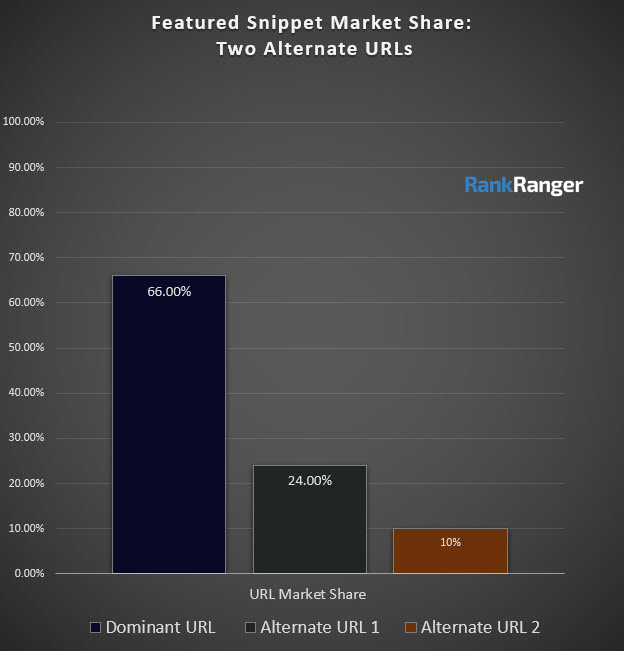
The most notable takeaway, and what I was most curious about at the onset, is from where does that third URL get its market share? That is, does Google siphon market share from the dominant URL or from the alternate URL when it decides to utilize a third URL for a Featured Snippet?
As you can see here, and interesting enough, Google mainly funnels market share from the dominant URL. Whereas the dominant URL’s market share stood at 77% when Google utilized but two URLs within the Featured Snippet, that number drops to just 66% when another URL is introduced. This compared to the “initial” alternate URL (Alternate URL 1), which saw its average market share actually move up a point (which, of course, is statistically negligible).
That said, the “second” alternate URL has what is all but a minimal market share that averaged in at 10%. Meaning, it’s a bit of an outlier and as such its placement inside a Featured Snippet has minimal value as compared to the dominant URL and even to the initial alternate URL.
Featured Snippet URL Market Share Takeaways
There’s a lot to say on this data (obviously) and you can take a conversation as to what it means in a wide variety of directions. That said, here are a few takeaways that struck me along the way:
Know What’s What with Your Featured Snippets
Sure, you could say I’m suggesting this as the top takeaway because I work for a company that offers multiple Featured Snippet tools… or it could be because there’s a significant difference in being the dominant Featured Snippet URL as compared to the “alt” URL! The data almost screams that tracking a Featured Snippet win in isolation is not enough. Rather, you need to determine if your win reflects you being the dominant or the alternate URL. This is all the more applicable when Google goes with more than one alternate URL. In fact, in such instances, even if you’re the dominant URL within the Featured Snippet it makes sense to pay close attention each day to see what that placement looks like, since, as we saw, Google siphons additional alternate URL market share from the dominant URL.
Featured Snippet URL Market Share Is Not a Zero-Sum Game
Despite Featured Snippet URL market share overwhelmingly belonging to the dominant URL, there is hope. I’m saying, there’s a chance! There’s a chance that your page reflecting the alternate Featured Snippet URL is a pretty decent win. That is, while the average alternate Featured Snippet URL has a market share around 25% a good chunk of them have a much greater hold. Our keyword data-set showed that 20% of keywords that produced a Featured Snippet that oscillated between just two URLs have a market share of 40% or more! That’s nothing to sneeze at. So if you’re thinking, “I already know I don’t have the dominant URL anyway,” it’s worthwhile to pay attention to it regardless because it could be you have a gem on your hands.
It Pays to be a Featured Snippet Hawk!

Before I send you on your way
All roads lead to the notion that Google’s Featured Snippet behavior has less to do with keyword intent and more with the nature of the SERP feature itself. This makes it a bit harder to offer advice for sites that focus on a particular type of keyword and the like. Rather, it makes my earlier point more poignant. Without even as much as a general pattern of behavior for a given keyword subset, your best bet is watching your Featured Snippet performance like a hawk. Be the hawk!




